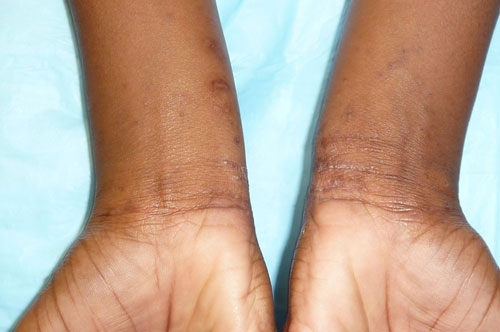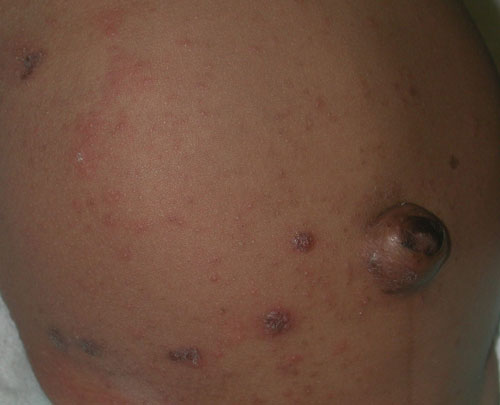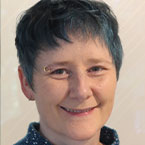By: Sarah Asch, MS, MD, FAAP, FAAD
Scabies is an itchy rash caused by the human itch mite. Adults, children and babies can all get scabies. Many people believe scabies is about cleanliness, but that is not true. Scabies can affect anyone, and it does not mean that someone who gets it is "dirty." It is easily passed between people living closely with other people. Let's discuss how scabies makes you itchy and how to get rid of scabies safely.
What causes scabies?
The human itch mite is microscopic in size. It can burrow into the very top layer of the skin (not any deeper), where it can lay eggs and eat. The mites are so tiny, there is no way to see them by looking with your eyes before the scabies rash starts. After a few days or weeks, an itchy rash develops in reaction to the mites.
What does scabies look like in children?
 Scabies rash looks different at different ages. Babies and toddlers, very elderly people or people with weakened immune systems can have a rash all over the body. In older children and adults, the rash is mostly on the hands, feet, armpits, belly button and genitals. It can look like hives (welts), pimples (pus bumps), blisters (tiny areas of fluid filled skin) or crusty bumps. But some people do not react with rash at all. It is very common to have 1 or 2 people with a rash in the house, but everyone at home is exposed and needs to be treated.
Scabies rash looks different at different ages. Babies and toddlers, very elderly people or people with weakened immune systems can have a rash all over the body. In older children and adults, the rash is mostly on the hands, feet, armpits, belly button and genitals. It can look like hives (welts), pimples (pus bumps), blisters (tiny areas of fluid filled skin) or crusty bumps. But some people do not react with rash at all. It is very common to have 1 or 2 people with a rash in the house, but everyone at home is exposed and needs to be treated.
How can my doctor tell if my child has scabies?
Scabies is diagnosed by looking carefully at the skin. The pattern of the rash, along with the story of when it started and who else is itchy, is usually enough for diagnosis. Sometimes your doctor may perform a skin scraping to look for the mite or other clues under the microscope.
How to get rid of scabies
To get rid of scabies, you have to treat the people and the environment you live in all at the same time. All the people who come into regular contact need to be treated. This means everyone who lives with you, and regular visitors such as babysitters and grandparents.
How you apply the treatment cream for scabies makes a big difference.
 Permethrin 5% cream is the most commonly used medicine to treat scabies in adults, children and infants. In babies and toddlers (under age 2), the cream is applied to the scalp, neck and over the whole body to the toes. In older children and adults, the cream is applied from the neck down to the toes. The cream needs to get into all the body folds (armpits, belly button, crack of the buttocks, around the scrotum and penis) and spaces between the fingers and toes. It does not need to be used on the face.
Permethrin 5% cream is the most commonly used medicine to treat scabies in adults, children and infants. In babies and toddlers (under age 2), the cream is applied to the scalp, neck and over the whole body to the toes. In older children and adults, the cream is applied from the neck down to the toes. The cream needs to get into all the body folds (armpits, belly button, crack of the buttocks, around the scrotum and penis) and spaces between the fingers and toes. It does not need to be used on the face.
Permethrin cream is left on the skin overnight for 8-14 hours before it is rinsed off the next day. The treatment needs to be repeated in one week to take care of any eggs that hatched after the first treatment.
There are other creams and oral medicines that are sometimes needed in specific situations. Not all medications can be used in very young infants and pregnant women. Your doctor will help prescribe the right scabies treatment for your family.
You said, treat the people AND the environment. What do we need to clean and how?
The mite can live for short periods of time outside of the skin on cloth items. This can be clothes, stuffed animals, bed linens, towels, soft parts of strollers, car seats, furniture and highchairs to name a few places. To get rid of scabies from the home, wash clothing, bed linens and towels using hot water and dry using the hot cycle. Vacuum furniture, carpets, car seats and strollers. If you can't wash or vacuum an item due to size or because it will damage it, you can place it in a sealed bag for at least 72 hours (3 days). Where needed, items can be dry-cleaned.
Do I need to treat my pets or get an exterminator?
No. Your pets do not get human scabies. You do not need a special exterminator, just careful cleaning of the bed linens, furniture and other items as listed above.
When can we all go back to daycare, school or work?
The great news is that this won't keep you isolated for long. You can all return to normal activities the day after all family members have started treatment, which means the day after the first overnight application of the permethrin cream.
We did all the treatments, but we are still itchy! What's the problem?
Sometimes after the scabies are gone, children and adults can be itchy for several weeks. There are other topical medications that can be helpful with this problem. It is called "post-scabetic pruritus", which means "after scabies itch". It can make parents nervous, but is very common especially if your child had a big rash due to scabies.
But how do I know if I have cleared the scabies?
Scabies goes away very well when the treatments and cleaning steps are followed carefully. But, if you, your child or anyone in the house is still getting new bumps two weeks after the last treatment, that person needs to be checked again.
What is crusted scabies?
Crusted scabies is when a person has a very large amount of scabies mites on their skin and they are present in large crusts. It is a very contagious version, because it has a lot of scabies mites to pass around. It can occur in people with weakened immune systems. It has a distinctive appearance and is quite rare in children.
6 things to remember about scabies
Be checked for scabies if your child has a new itchy rash, especially if other family members start to itch too!
Use the prescribed creams as explained above for all household contacts two times, one week apart. Treat everyone all at the same time.
Right after the skin treatment, start cleaning the home and doing the laundry as explained above.
You do not need an exterminator. You do not need to treat your pets.
Scabies is common, and it does not have anything to do with being clean. It is just a little bump in the road of life!
Any questions or concerns along the way, make sure to check with your doctor.
More information
About Dr. Asch
 Sarah Asch, MS, MD, FAAP, FAAD is a member of the AAP Section on Dermatology, Education Committee and is proud to be a 2022-23 Walter W. Tunnessen, Jr., MD Visiting Professor providing pediatric dermatology lectures for pediatrics residents. She is also a member of the Section on Telehealth, and the Chair of the Society for Pediatric Dermatology Teledermatology Committee. She is a pediatric dermatologist in a solo teledermatology and mobile pediatric practice aimed at underserved and rural populations in the Upper Midwest. She currently serves as an adjunct faculty at the University of Minnesota. Sarah Asch, MS, MD, FAAP, FAAD is a member of the AAP Section on Dermatology, Education Committee and is proud to be a 2022-23 Walter W. Tunnessen, Jr., MD Visiting Professor providing pediatric dermatology lectures for pediatrics residents. She is also a member of the Section on Telehealth, and the Chair of the Society for Pediatric Dermatology Teledermatology Committee. She is a pediatric dermatologist in a solo teledermatology and mobile pediatric practice aimed at underserved and rural populations in the Upper Midwest. She currently serves as an adjunct faculty at the University of Minnesota.
Impetigo images courtesy Sarah Stein, MD, FAAP, FAAD |